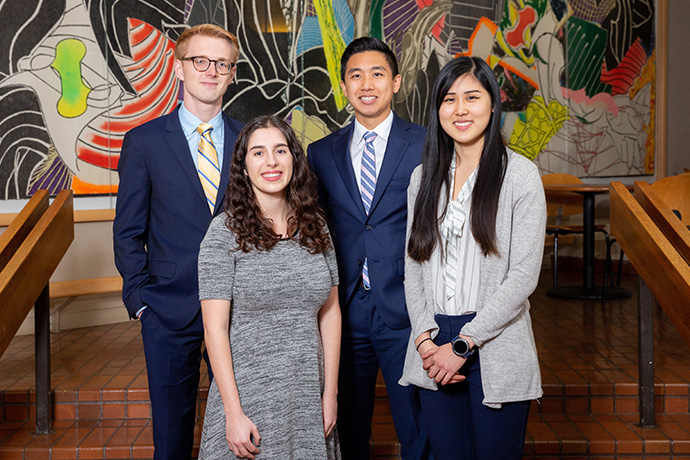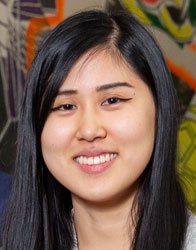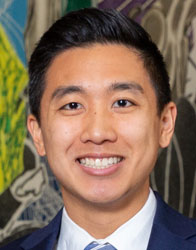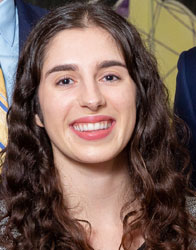Medical Student Research Forum: Oral Presentations
Among the 103 applicants for this year’s Medical Student Research Forum, four students were selected to give oral presentations of their work to an audience of their colleagues and faculty mentors from across campus. They were gifted $100 for that honor.

Amy Kuprasertkul – Oral Presenter

Research project:
Prostaglandin E2 (PGE2) in Urine of Post-Menopausal Women with Recurrent Urinary Tract Infections for Monitoring of Urinary Tract Infections
Why this project?
“I love women’s health. I’m an officer of V-Day, a global movement to end domestic violence, have worked in an infertility clinic in the past, and have done tons of related volunteering. I’m so excited to work with Dr. Philippe Zimmern and Dr. Nicole De Nisco, whose patient population and research focus is female. I get to participate in science that’s devoted to struggling women, those with recurrent urinary tract infections.”
Mentor: Philippe Zimmern, M.D., Department of Urology
Research summary:
“Urinary tract infections (UTI) affect 150 million people per year worldwide and cost the U.S. $3.5 billion per year. People get many recurrent infections and are becoming resistant to antibiotics, so we need alternative treatments. Research in mice showed more inflammation with recurrent UTIs (RUTI) and improvement with treatment with anti-inflammatory medications like NSAIDs (ex. ibuprofen).
Our goal was to study inflammation in post-menopausal women with RUTI. We took bladder tissue from women with RUTI and found the presence of inflammatory enzymes, like COX-2. Then we tried to find a noninvasive way to monitor these patients. We took their urine and measured PGE2, which is a product of the COX-2 enzyme. Compared to patients who have never had a UTI, we found higher PGE2 levels in RUTI patients, supporting that they have more inflammation.
We think PGE2 could be a urine biomarker to help us identify a subset of women with a lot of inflammation in their bladder. If so, these women might benefit from adding anti-inflammatory (anti-COX2) medication to their antibiotic treatment, so that they don’t keep getting infected over and over.”
Dang-Huy Do – Oral Presenter

Research project:
Multivalent Adhesion Molecule (MAM7) Inhibits S. aureus Infection in a Surgical Incision Rat Model
Why this project?
“I am interested in general surgery, so when seeking out research opportunities in that field, I was particularly interested in this project.”
Mentors:
Ryan Huebinger, Ph.D., Department of Surgery
Deborah Carlson, Ph.D., Department of Surgery, Department of Pediatrics
Research summary:
“Antibiotic-resistant bacteria have complicated the problem of tackling infections. When developing new drugs, one way to prevent antibiotic resistance may be to target the bacteria’s invading potential, rather than its ability to survive. Multivalent Adhesion Molecules (MAMs) are a group of molecules on the outside of bacteria that are necessary for their binding to human tissue and subsequent invasion into it. A novel “MAM7 inhibitor” was recently created. It is composed of multiple MAM fragments bound to a special bead, in order to mimic bacteria. The MAM7 inhibitor prevents bacteria from initially attaching to human tissue by blocking where the bacteria would typically bind. Because the bacteria cannot invade, the immune system can more easily clear it.
We wanted to test this MAM7 inhibitor against Staphylococcus aureus, a notoriously common and often antibiotic-resistant infection in surgeries. Using UTSW-approved protocol, we tested the efficacy of MAM7 inhibitor against S. aureus in a surgical incision model. Our results showed that there was a significant reduction every day in the number of bacteria in animals treated with MAM7 inhibitor as compared to animals that received a control. Additionally, the MAM7 inhibitor did not interfere with normal wound healing or induce inflammation in the wound.”
Layla Samandi – Oral Presenter

Research project:
Prevalence of Esophageal Fibrosis in Eosinophilic GI Diseases
What did you get out of this experience?
“Being able to present to such a large group was a big learning opportunity for me. It taught me how to distill a complicated topic into something that people without a background in my research could understand, which is a key skill to have as a future physician who will be trying to explain complicated diseases to my patients. The forum also helped me gain confidence in presenting in front of a big crowd.”
Mentor:
Edaire Cheng, M.D., Department of Pediatrics, Division of Pediatric Gastroenterology
Research summary:
“My research focuses on eosinophilic gastrointestinal diseases (EGID), which are chronic, immune-mediated (the triggering antigens are usually foods like wheat, milk, etc.) diseases characterized by eosinophilia (elevated numbers of white blood cells that are associated with allergic reactions) anywhere throughout the gastrointestinal tract, accompanied with gastrointestinal symptoms like difficulty swallowing, food impaction, vomiting, and diarrhea or constipation. The most common of these EGID is eosinophilic esophagitis (EoE), which is characterized by eosinophils only in the esophagus.
My project looked at comparing patients demographically, endoscopically, and histologically with EoE to patients with non-esophageal EGID that also had eosinophils in their esophagi. We found that they were similar, which suggests that not all EGID might be separate diseases as previously thought, but instead may make up part of a spectrum. This is clinically important because if a physician has a patient with EoE who is exhibiting a non-esophageal symptom such as constipation, they may want to consider evaluating them for a non-esophageal EGID.”
Reilly Sample – Oral Presenter

Research project:
Characterization of Poxvirus A51R Protein-Mediated Modulation of Host Microtube Networks
What did you get out of this experience?
“I learned how much work scientists put into their research. Lab research is an art that requires an immense amount of dedication and persistence. When we read research papers, we see figures and tables, but what we don't see are the hours of design and execution of experiments that took so much work.”
Mentor:
Don Gammon, Ph.D., Department of Microbiology
Research summary:
“This summer I had the pleasure of working in the Department of Microbiology under Dr. Don Gammon and his lab members. Dr. Gammon's research advances our knowledge of how viruses both evade host immune responses and hijack normal cell systems in order to replicate and cause disease. My project focused on the ways that poxvirus, a DNA virus notorious for causing smallpox in humans, targets host cells' microtubules, or structural scaffolding, in order to replicate successfully. Understanding how and why poxviruses manipulate their hosts this way will allow us to uncover the mechanism by which other similar viruses attack their hosts. By further advancing our knowledge of host-virus interactions, we can discover new targets for potential antiviral therapies and better treat and prevent the diseases that they cause.”
Dr. Zimmern holds the Jane and John Justin Distinguished Chair in Urology, in Honor of Claus G. Roehrborn, M.D.

